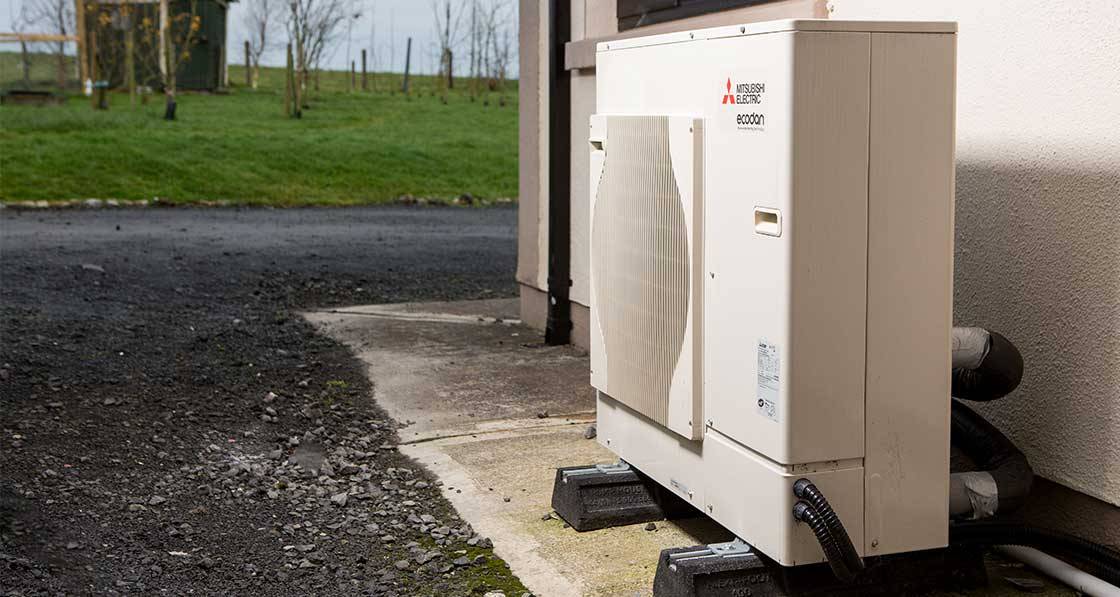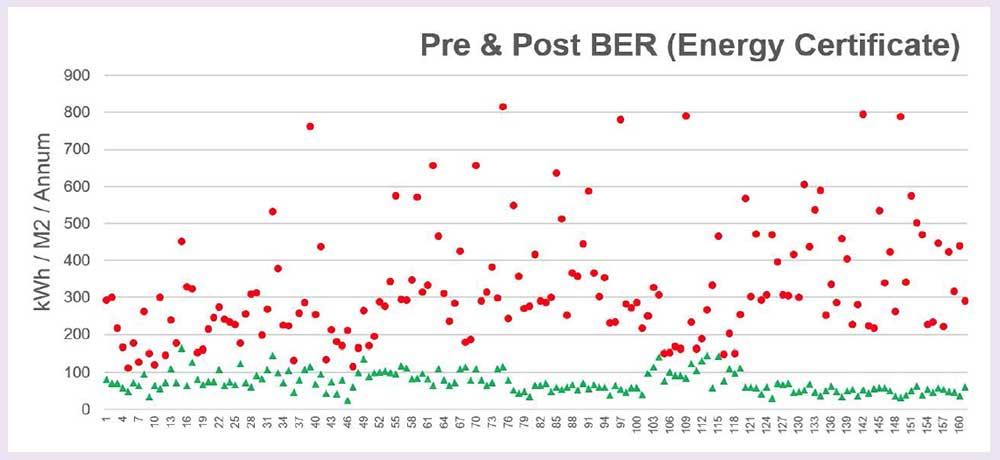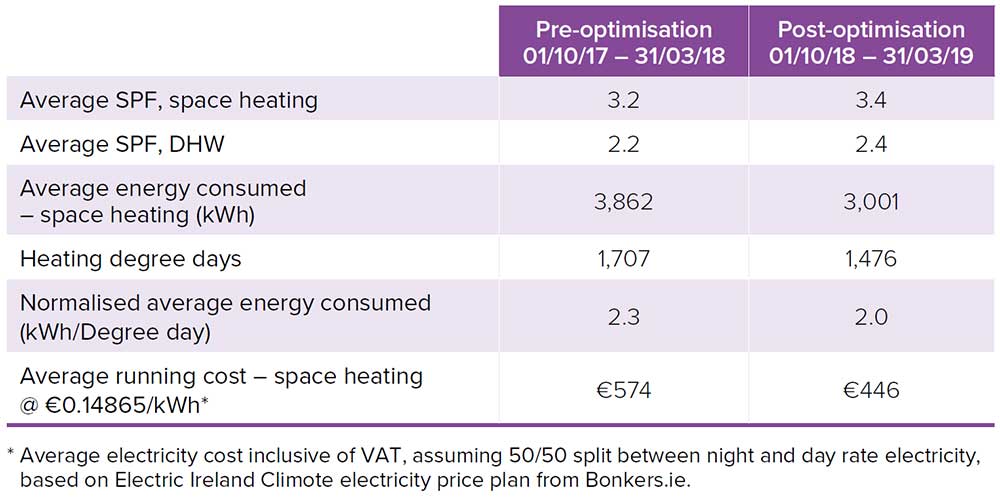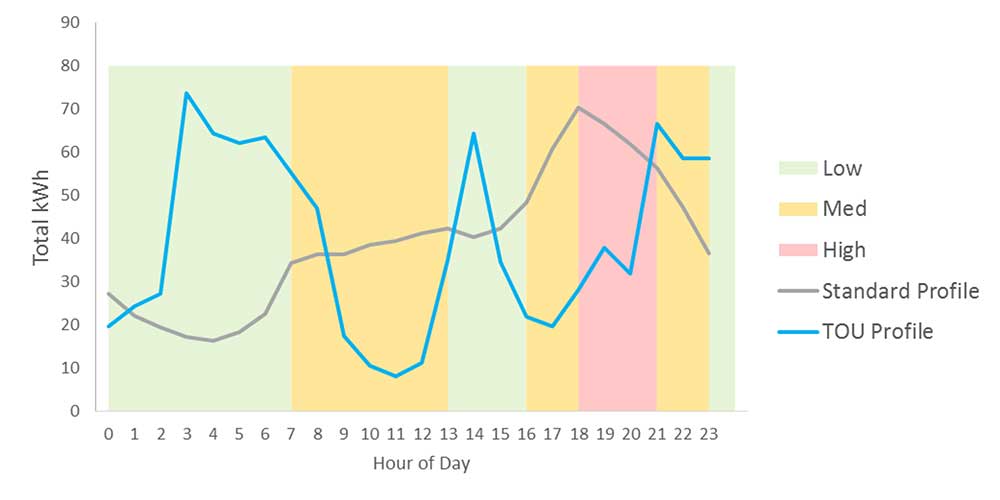
- Insight
- Posted
Evidence base: How air source heat pumps fare in canny retrofits
Air source heat pumps are rapidly becoming one of the dominant technologies in sustainable building, but how well do they perform in real world conditions? Can they be part of the solution to retrofitting homes, given the challenges in making existing homes suitable for low energy heating? A rare monitoring study on a pioneering retrofit scheme offers encouraging signs.
This article was originally published in issue 30 of Passive House Plus magazine. Want immediate access to all back issues and exclusive extra content? Click here to subscribe for as little as €10, or click here to receive the next issue free of charge
As the electricity grid continues to decarbonise, the environmental benefits of electrifying heating keep on improving, a process that’s bound to continue in the coming years. Add in the prospect of heat pumps multiplying each kilowatt of electricity into three or more kilowatts of heat and the argument can become compelling.
Analysis by Passive House Plus indicates that the majority of new homes built in Ireland last year are heated via air source heat pumps (ASHPs), which help meet both the energy efficiency and renewable energy targets set out in Part L of the building regulations. But this technology – which is rapidly moving from the margins to centre stage in the UK and Ireland – is still comparatively new in these markets, at least in terms of en masse roll out, meaning many people still have doubts about their real world performance.
These doubts are most pronounced in the case of retrofitting heat pumps, and the reason isn’t hard to establish: the efficiency of a heat pump is better when the delta T – the distance in temperature between two measuring points – is lower. That ideally means trickling low temperature heat into a large surface area distribution medium such as an underfloor heating system, and into a building which has thermally efficient building fabric, and is therefore comparatively warm to begin with, and slow to lose heat. Existing buildings tend to be far from this scenario, with building fabric that’s quick to lose heat, and boilers set up to blast heat in at high temperatures into radiators.
Tipperary Energy Agency CEO Paul Kenny and his colleagues had a vision for a different approach. In 2015 the agency launched SuperHomes, a grant-funded retrofit scheme set up with the ambition of delivering cost-effective deep retrofits with a specific, tightly-defined approach: fabric heat loss is reduced by airtightening (to a q50 of less than 5) and insulating homes, while ventilation heat loss is reduced without compromising indoor air quality via demand controlled mechanical extract ventilation systems. By reducing heat losses, an ASHP could be run at relatively low temperatures via the home’s existing heating system – in some instances with additional radiators added to increase the surface area of heat emitters. Crucially, the retrofit measures – including heating system changes – would be designed by sufficiently qualified engineers, with well-trained and supported installers, professionally managed contracts, finance and compliance checks. The works were done by a group of dedicated installers: Sola, Leetherm, Churchfield, House2Home and Waterford Insulation.

Before and after primary energy scores from BERs for homes which have received energy upgrades under the SuperHomes scheme.
Costs were kept impressively low: participating households in year one made a net spend of €18,000, after 35% of the costs had been covered by a SuperHomes grant Lack of post occupancy data is arguably the greatest failing in attempts at low energy building, an informational vacuum that creates uncertainty about whether a given energy saving attempt is working or not, which therefore undermines consumer confidence.
Such an evidence-blind approach may not stop energy saving measures being installed in new buildings – albeit without the means of quantifying whether they proved successful – provided they’re mandated under building regulations. But kickstarting en masse retrofit of existing buildings means convincing consumers to make changes to their home.
Until the day that governments actually force people to upgrade their homes, that means using a mix of incentives and penalties, and giving consumers compelling evidence that they’re making the right choice.
In the case of SuperHomes, Tipperary Energy Agency’s relationship with Limerick Institute of Technology (LIT) – the agency’s founder and chairperson, Seamus Hoyne, is now head of development at LIT – provided an opportunity to prove the concept. The agency partnered with LIT’s Research, Development & Innovation section, who conducted a two-year monitoring study, SuperHomes 2.0. Led by Hoyne and LIT research fellow Padraic O’Reilly in conjunction with LIT’s Mick O’Shea and Geoff Hunter, the study commenced in April 2017 with additional partners of ESB Innovation, Electric Ireland and ESB Networks, and funding via the International Energy Research Centre (IERC) in Cork.
20 homes that went through SuperHomes deep retrofits from 2015 to 2016 were chosen for the study, looking at their performance over a two year period. 19 homes were fitted with Mitsubishi Ecodan heat pumps, while one had a Dimplex unit. The SuperHomes scheme aims to bring homes up to an A3 building energy rating, subject to what’s possible and cost-effective in a retrofit: the 20 homes in the monitoring study included two A2s, twelve A3s, four B1s, a B2 and B3. 18 of the homes were detached, along with two semi-ds. 15 are rural and five are urban, and the average size is 195 sqm. Seven homes had a mix of underfloor heating and radiators, one had only underfloor, and 12 had only radiators – meaning the heat pumps would have to run at higher temperatures. Some of the underfloor heating was comparatively old, with fairly poor levels of ground floor insulation.
Water tank temperatures were generally set at between 45 – 50C. Immersion heaters were not used for space heating at all, with immersion use restricted to giving hot water an 8C lift up to 60C at the end of the legionella protection cycle once per fortnight, consuming an encouragingly small amount: approximately 70 kWh of electricity annually per house.
The flow temperature range for heat emitters ranged from between 36 and 48C with weather compensation, providing evidence that the strategy of reducing energy demand and thereby enabling radiators to be run at low temperatures is working.
The performance of the heat pumps in all 20 homes was monitored in year one, with their efficiencies assessed in line with a defined seasonal performance factor, which looks at the total energy input and output of a heat pump. The total amount of heat supplied by the heat pump for space heating and to the domestic hot water tank, added to any heat produced by electric immersions is divided by the total amount of electricity to power inlet fans/pumps, auxiliary heaters, heat pump, immersion and any fans or pumps included in the heating or hot water system.
In year one, the monitored homes averaged SPFs of 3.2 for space heating and 2.2 for domestic hot water – a result which compares remarkably favourably to the Energy Saving Trust’s field trials.
After year one, 15 of the heat pumps were optimised and effectively re-commissioned, with the remaining five left as a control group. This meant that any improvements in performance gained from changes made to the system could be compared not just against the previous year’s data – which could provide lower or higher performance depending on factors such as the number of heating degree days in a given year – but against other unoptimized homes. The figures improved again: average SPFs of 3.4 for space heating and 2.4 for domestic hot water. By comparison, the EST’s field trials on ASHPs showed SPFs (averaged for space heating & hot water) of 2.45 post-optimisation.
Based on a total of 3,862 and 3,001 kWh consumed for space heating pre and post-optimisation, the costs would translate to annual space heating costs of €574 in year one, and €446 in year two – impressively low figures for relatively large, mainly detached homes.

Cycling
One critical factor that affects both the efficiency and life span of a heating appliance such as a boiler or heat pump is the cycle rate – or the frequency at which the appliance turns on an off to deliver a required temperature.
Padraic O’Reilly explains that EN 15450 of 2007 talks about limiting the number of cycles to three per hour. “ESB Networks documentation on rural connections looks for four starts per hour - because they don’t want big surges.”
After optimisation, the maximum number of cycles was reduced from 14 to 6 per hour. But the average in year two was far lower: 410 cycles per month. Based on ten hours of heating per day over a month, the average cycle rate worked out at less than 1.35 times per hour. A critical factor in achieving this was matching up of heat pump with heat emission system, by ensuring the operating temperatures are correct. “If they’re too low, you have a mismatch, which causes cycling,” says O’Reilly. Excessive cycling will shorten the lifespan of the compressor. According to O’Reilly, this was perhaps the main takeaway from the tweaks applied after year one. “The most important outcome of optimisation was the reduction in cycles, at the same time improving the satisfaction of internal target temperature while maintaining or improving efficiency.”
Time-of-use tariff
ESB trialled a new ‘time of use’ tariff on eleven of the homes, with smart pay-as-you-go meters installed between April and May 2018 – with in-home displays showing the customer the tariff and their consumption. The results are encouraging. Electric Ireland’s Aine Doran presented results at the SuperHomes 2.0 conference in April including examples showing users shifting away from the standard profile of usage, with usage peaking in the middle of the night and mid-afternoon – capitalising on the lowest tariffs – and delaying evening usage to peak at 9pm, when pressure on the grid is starting to ease.
But what do the homeowners who participated in this study think? Positive-looking hard data is one thing, but the participants in SuperHomes 2.0 also had plenty to say about their upgraded homes. “No matter what the weather’s like outside, it’s always warm once I step inside,” says one homeowner. “Never use the clothes dryer anymore, says another, who finds the combination of consistently warm radiators and humidity-based ventilation is “great for drying the clothes”. Some participants also talked of having homes that are always warm, always having hot water, and the convenience of not having to order fuel – or worry about oil being robbed. But it’s not all positive: “Can’t keep fruit and veg out without it going off,” reported one person.
At the time of writing, the SuperHomes 2.0 project is currently being finalised. 10 of the participating homes also had solar PV arrays fitted, and in one home LIT have assessed the potential for PV output to be matched to the ASHP demand, as well as looking at charging electric vehicles and storage options, working with energy storage specialists Solo Energy.
But the project has already served an extremely important purpose: it has shown that there is real substance in the theory put forward by Tipperary Energy Agency when they launched such a tightly-defined scheme for subsidised deep retrofits, and attracted significant attention from the joint Oireachtas Committee on Climate Action while it deliberated on proposed interventions to drastically reduce carbon emissions across Ireland’s existing housing stock. Only time will tell if the key findings from SuperHomes – not just with regard to the notion of combining specific interventions on energy efficiency, renewable heating and ventilation, but also, crucially, the role of design professionals in the works – end up being heeded.

(above) Time of use (TOU) profile with low, medium and high tariffs allocated to six different time slots throughout the day, in order to see whether price could motivate occupants to use their heat pumps outside of peak hours – including at times of low demand during the day, rather than just the simpler day/night rate options.
THE UTILITY’S PERSPECTIVE
Passive House Plus spoke to project partner, ESB eHeat manager Brian Montayne to discuss the significance of the study’s findings.
PH+: What do you think the implications of the results from SuperHomes 2.0 are?
BM: The results have confirmed that heat pumps can very efficiently meet the heating and hot water needs of Irish homes. It has further demonstrated that with the application of best practice installation strategies, further efficiencies can be realised and that scale up of heat pump deployment to meet national decarbonisation objectives offers significant potential. In fact heat pumps offer an immediate climate friendly solution for the 500,000 new homes we are expected to deliver by 2050, avoiding fossil fuel lock-in and guaranteeing sustained carbon reduction without the need for further costly intervention by the homeowner.
PH+: What actions does ESB expect to take based on the information gained from SuperHomes 2.0?
BM: It is our intention that the findings from SuperHomes 2.0 will be leveraged to inform best practice heat pump design & installation standards and guidance so that homeowners can have confidence that their low carbon heating system is delivering to its potential.
PH+: What role does ESB see heat pumps playing in decarbonising heat, and what role does ESB expect to play in this?
BM: ESB believes that heat pumps can make a significant contribution to the decarbonisation of Ireland’s heating sector. An average Irish home currently emits 58% more carbon than the average EU home due to greater use of high carbon fuels. Transferring to electric heat pumps in conjunction with an energy retrofit will offer immediate benefits from a carbon reduction perspective and will deliver co-benefits in terms of creating healthier living environments and reduced energy costs.
Electricity production is transforming with the large scale deployment of renewables having already delivered a 50% reduction in carbon intensity from 1990 levels, with a further 30% reduction envisaged by 2030. Today, ESB is leading this transition to a low carbon energy future, powered by clean electricity. This involves investing in low carbon and renewable generation, developing a smart network capable of supporting the further electrification of society and empowering customers to take more control over their energy use. As high carbon electricity generation is replaced by low carbon and renewable alternatives, heat pumps will contribute progressively more carbon savings over time making them a truly future proofed heating option for homeowners.
PH+: Are we likely to see a time of use tariff being launched onto the market any time soon?
BM: We envisage that smart metering will facilitate the introduction of new customer propositions in the years ahead – in the mean time homeowners can take advantage of day/ night tariffs that are ideally suited to all-electric dwellings
PH+: Would ESB consider being involved in further research to see to what extent heat pump use has the potential to correlate with wind energy generation?
BM: ESB will continue to support R&D that facilitates large scale deployment of low carbon technologies that will optimally leverage Ireland’s increasing renewable electricity resources.



